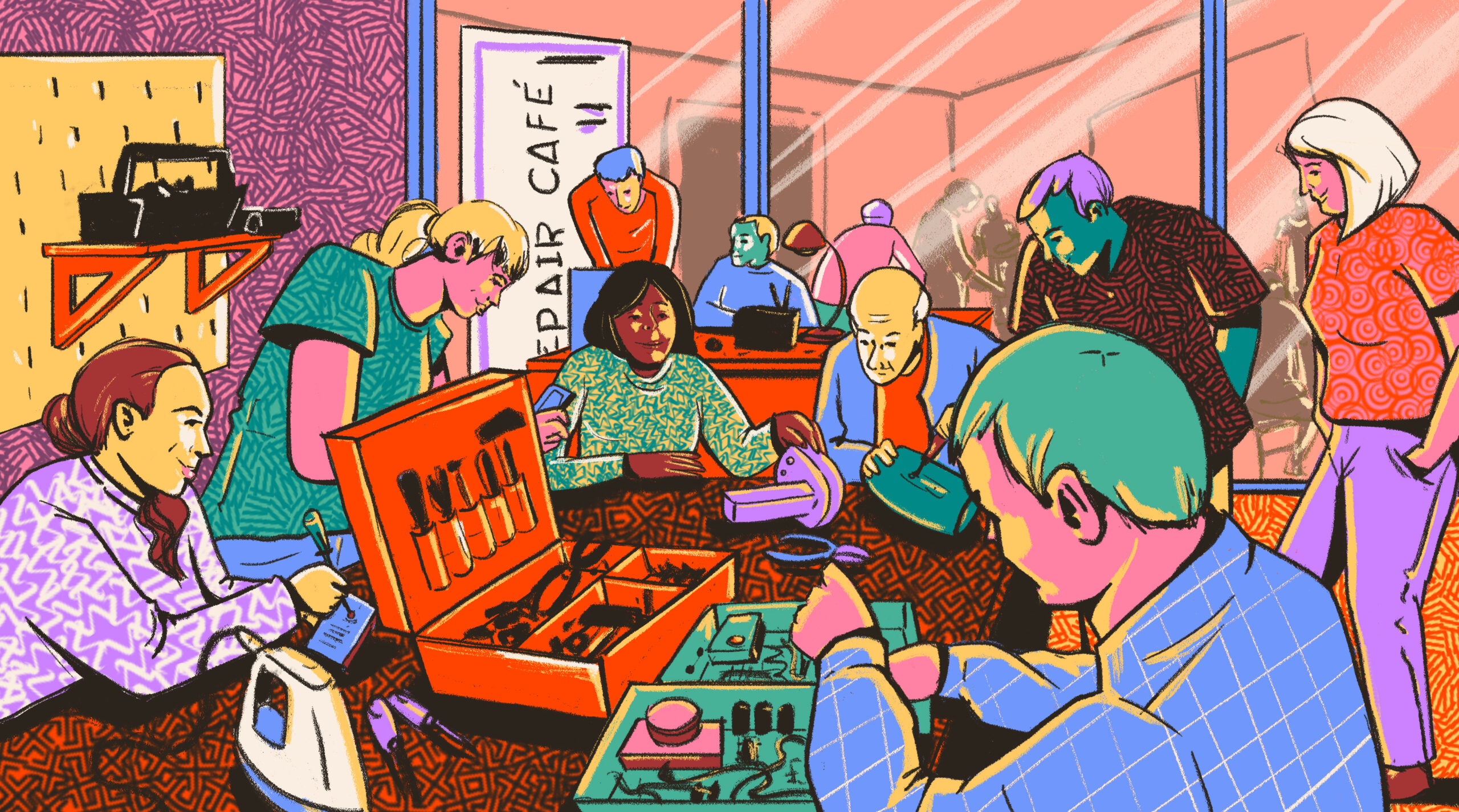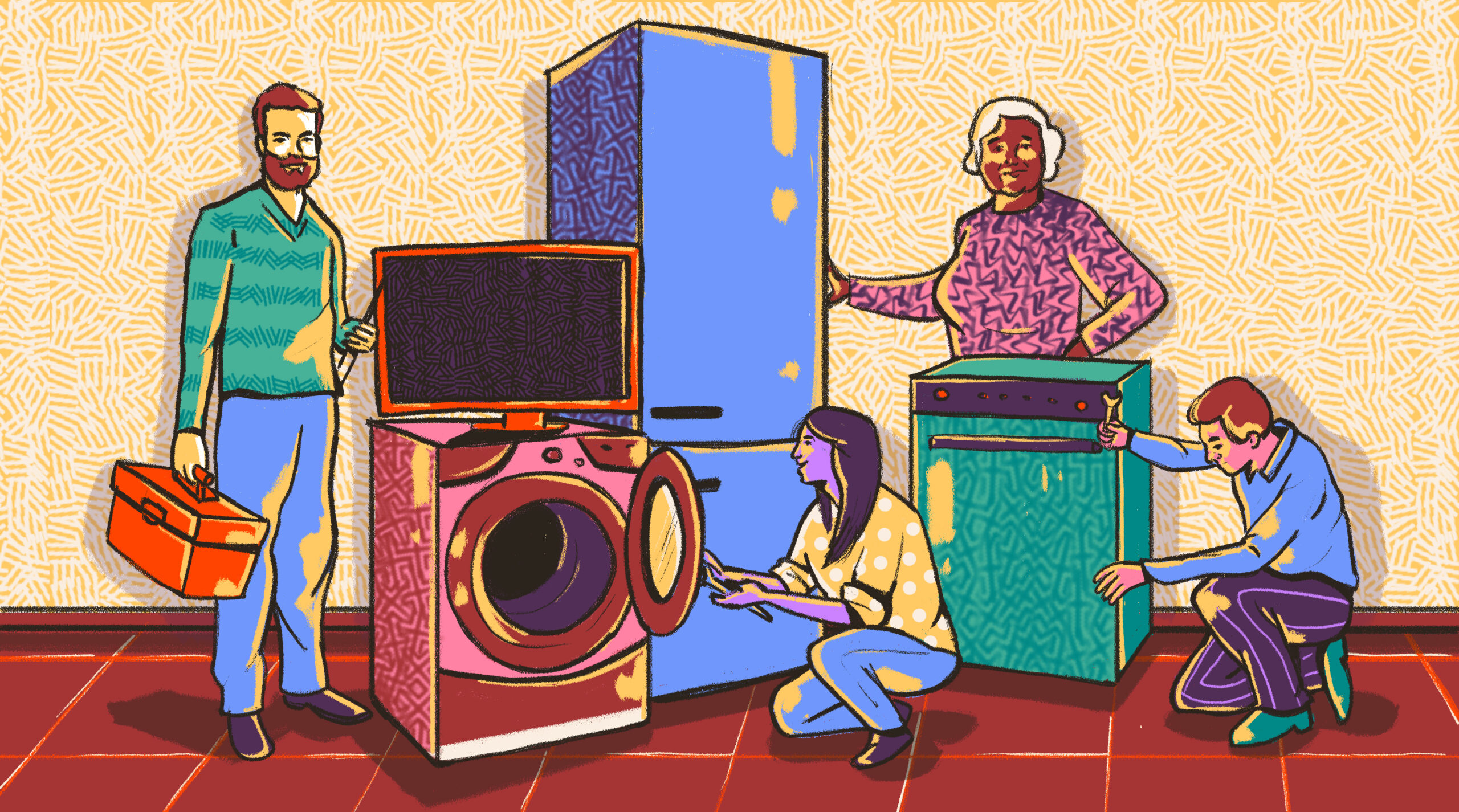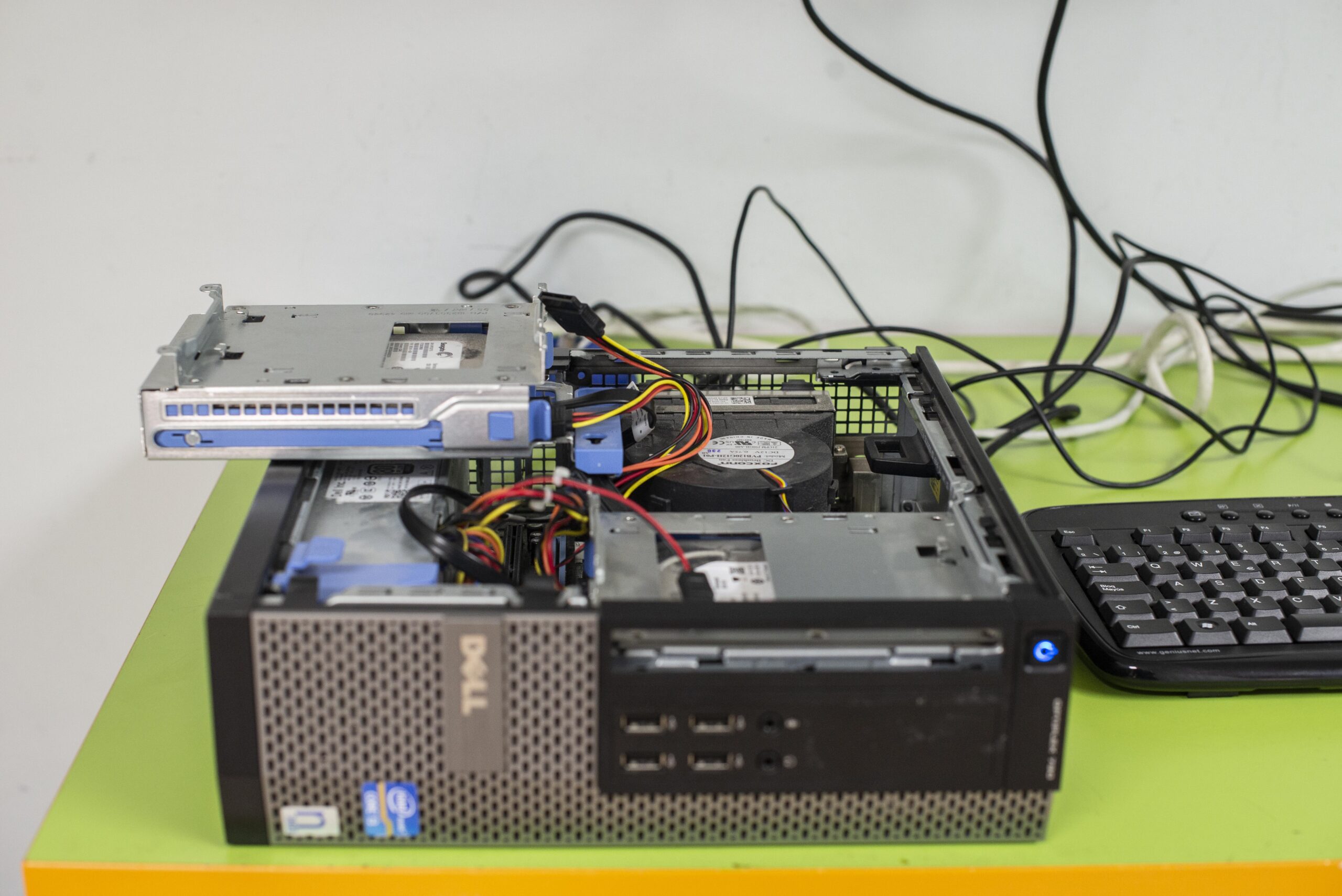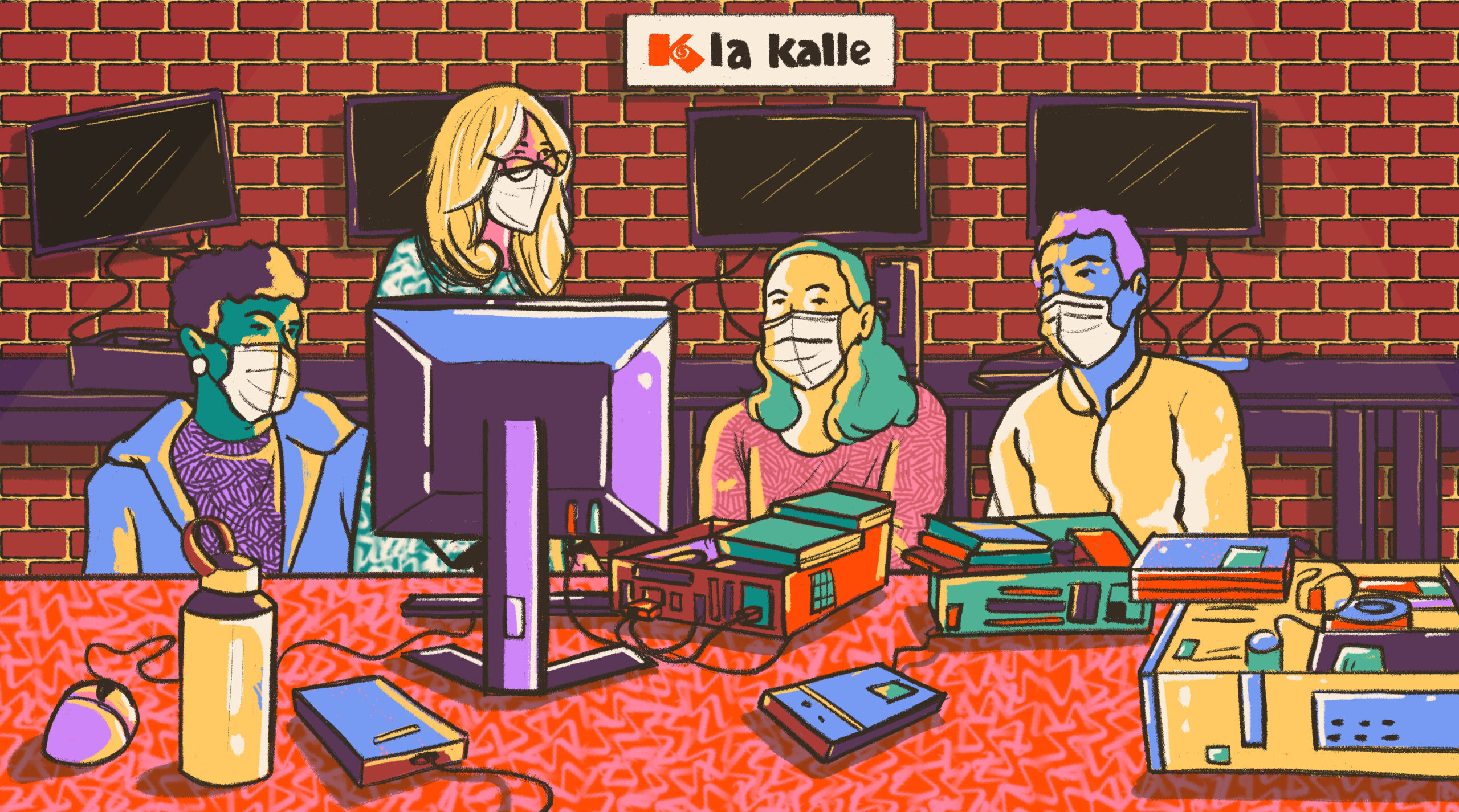
THE REPAIRERS
How Europeans Are Fighting e-Waste through Circular Economy Initiatives
Lola García-Ajofrín
With more than 12 million tons of broken equipment yearly, Europe ranks second only behind Asia in terms of electronic waste (e-waste). Circular economy initiatives across Europe aim to reduce emissions linked to consumption.
Illustrations by Lorena Barrios.
“It will cost you almost the same to repair it as to buy a new one.” Most visitors have heard this sentence before arriving with a broken toaster or hairdryer at the Repair Café MediaLab-Prado in Madrid. The Repair Cafés are meeting points that emerged in the Netherlands in 2009, where people bring broken items from home and a team of volunteers help them repair them. In this way, they can avoid the rapid purchase cycle of buying, using, discarding and buying again while creating a community of repairers. There are over 1.500 Repair Cafés like this one in the world.
“Most of the appliances that people bring, such as toasters, blenders and dryers, are easy to repair,” explains Javier Vazquez, one of the volunteer repairers at this Repair café in Madrid, during a weekly meeting. During the pandemic, they continued to meet via Zoom. “In many cases, they are just dirty with grease on the inside, but people are not used to opening an appliance and cleaning it.” “Now manufacturers do not make repair easy,” adds José Manuel Gutiérrez, who is currently repairing an old radio. He says that it was more accessible in the past. He explains that recently he tried to unscrew a broken fan that someone brought to this repair café, and he realized that “the screw looked normal, but it could not be unscrewed with a regular screwdriver.” He says that it has happened to him with several devices.
More and more citizens and associations claim a right to repair to fight the throwaway culture in recent years.
What do the European laws say?
On March 1, 2021, the European Union took an essential step in promoting the reparability of electronic devices by implementing the new EU Ecodesign measures, which oblige manufacturers of certain electronic products to make the repair easier.
The EU legislation on ecodesign is a tool that sets up mandatory minimum standards for the energy efficiency of the products that are sold within the European member states, ensuring that the low-performing items can no longer be sold in the EU countries. Lately, several revised versions have been published.
This year, the EU ecodesign measures include regulations related to enhancing the reparability and recyclability of appliances this year for the first time. Quite an achievement for those who demand a right to repair.
But, what do these new measures involve in practice?

The new ecodesign measures took effect on March 1 2021, and they apply for four types of electrical appliances – televisions or other electronic displays, fridges, washing machines and dishwashers.
Manufacturers or importers will be obliged to make a range of essential parts available to professional repairers for at least 7-10 years after the last unit of a model has been placed on the EU market.
Manufacturers are also obliged to supply spare parts within 15 days. In addition, they must ensure easier disassembly of their products.
Limitations – The ‘right to repair’ is closer but still far
Although the new EU Ecodesign measures are the first-ever EU regulation on repairing electronic equipment, it does not mean Europe has a “right to repair yet,” as organizations like the ‘Right to Repair’ campaign claim. Right to repair is a movement involving repair groups and environmental activists from nearly 40 organizations in 16 European countries that advocates for a universal right to repair, removing the barriers to repair the products so that they can last for longer.
At Right to Repair, they argue that the new regulations do not include mobile phones or laptops yet, which are some of the devices with the most premature obsolescence. They also say that the new measures will benefit professional repairers rather than consumers who want to repair their devices themselves, which is one of the campaign requests.
In addition, not all the measures have an immediate effect. “One thing that has started from 2021 is that the “design for repair and reuse” applies, this means the product needs to be designed in a way it can be disassembled,” explains Jean-Pierre Schweitzer, Policy officer for products and circular economy at European Environmental Bureau (EEB), which is Europe’s largest network of environmental citizens’ organizations with around 140 organizations in over 30 countries. “However, the other repair requirements: availability of spare parts, access to repair information will not come into effect until March 1 2023,” he adds.
In general, “it’s great that we have repair standards for products for the first time. But so far, the measures don’t have a noticeable effect on consumers because they only affect products that were newly put on the market after March 1 2021,” agrees Katrin Meyer, coordinator of Runder Tisch Reparatur in Germany, a member of the Right to Repair movement.
“Although we think these measures are a very important and a positive first step, we think the impact on consumers will be small,” says Rosalie Heens, project worker of Repair&Share. This organization supports the community of repairers in the dutch speaking part of Belgium with communication, manuals, digital tools, information and events. “It will be a bit easier, for some products, to open them, to order some spare parts and to find information on how to repair these devices. But the current regulation only focuses on a limited set of products, and for products that have been placed on the market since 2021 (so not for older products).” “In addition, for most of the spare parts, the access is limited to professional repairers,” Heens adds.
The project worker of Repair&Share believes that the Ecodesign measures “are a step forward” since “it was the first time that repairability is a criterion in regulation”. “A lot of work has been done, and now, there is a framework that the EU can use to create measures for other product groups,” she adds. “The coming years, for instance, the EU is going to develop regulations on smartphones, a product group with a big environmental impact, and lots of barriers to repair (glued batteries, expensive spare parts…).” “However it does mean to establish a right to repair, as access to spare parts is very limited,” she adds.
In Heen’s opinion, one of the main challenges these measures do not tackle is one of the main barriers to repair: money. “The price difference between new purchases and repairs is too small.” She explains that high prices of spare parts push both consumers and independent repairers to give up on repairing a product in many cases. “Another challenge is that the labour costs of repairers based in Europe are much higher than the labour costs of the workers manufacturing the products in countries with low labour costs,” she adds. Additionally, “the environmental cost of the production of new products is not taken into account.” “We need policymakers to bring this back into balance, to take measures that make environmentally harmful practices more expensive than environmentally positive ones,” Rosalie Heens concludes.

Electronic waste (e-Waste) is the fastest-growing category of household waste in the world. It increased by 21% in the last five years, according to the Global E-waste Monitor 2020 report. It represents an environmental and a health hazard, as e-waste contains toxic additives and dangerous substances such as mercury.
France – a reparability Index
Some European countries are already ahead and have adopted national regulations to fight the throwaway culture. France is the European country that has taken the most significant step in promoting reparability to date by implementing a “reparability index” for electronic products, which entered into force in January 2021. It is the first national label of its kind.

For instance, we searched “4K television” on the website of a well-known French company specializing in electronic products. The first item that appears is a TV that costs 1,199 euros. The repairability index (in yellow) is shown next to the price. It is 4.3 out of 10. We try again to search for a random smartphone, and the shown index (in green) is 8,6. The score, which ranges from 0 to 10, is based on five criteria: documentation, removability, parts availability, price of spare parts and other specific criteria. It aims to indicate to the client if the product in question is repairable, hardly repairable or non-repairable.
“We believe that initiatives like the French Repairability Index have more impact on consumers, explains Rosalie Heens from Repair&Share. She explains that they make it possible for consumers to compare devices on their reparability and make informed choices. They put pressure on manufacturers to make their products better repairable, as repairability becomes a selling point. “A crucial aspect of this French repair index is that the price of spare parts also is taken into account,” she continues. “If spare parts are expensive, the score will be affected negatively,” she adds. Heens explains that at Repair&Share, they are asking the Belgian government to adopt this score in Belgium.
As a downside, circular economy organizations criticize that the mark on their products is put by the companies themselves and not by a neutral organization.
TAX cut for repair services in Sweden and Austria
In 2017, Sweden introduced new tax laws, reducing taxes on repairs for some appliances such as refrigerators and washing machines with a 50-per cent tax deduction of the repair service cost.
Similarly, in Austria, they have a VAT reduction on certain repair services, including bicycles, shoes and clothing, reduced from 20 % to 10 %, making choosing to repair more attractive rather than throw away. “And they also have regional funds to subsidize repair of electronics by up to 100 EUR per year in a few cities,” Jean-Pierre Schweitzer adds.
In Spain – a longer guarantee
In Spain, in April 2021, the government approved the extension of the legal guarantee period for products up to three years (it was two) and to increase the minimum time in which manufacturers must have spare parts once up to 10 years (it was five years).
What about the future?
“The measures for TVs, washing machines etc., were adopted in September 2019, and they didn’t come into force until 2021,” Schweitzer explains. “So I think if we only have a proposal for smartphones at the end of 2021, it will not be adopted until 2022, and then it will take another year or more to come into force, so I guess 2023-2024 for the same rules for phones… not very fast,” he concludes.
Europe pursues a ‘product passport’
“The Commission is working on developing a comprehensive range of options for right to repair, considering the following three angles: consumers should be in the position to choose reparable (and durable) products; products need to be designed and made to be repairable, and producer responsibility schemes should promote repair operations,” Ana Crespo, Press Officer for Energy at the European Commission says.
Crespo explains that the European Commission also prepares its proposal for a Sustainable Product Initiative for the end of 2021. Under the Circular Electronics Initiative, “new rules will be developed to improve the circularity.” “The intention is also to develop digital ‘product passports’ that will provide information on a product’s origin, durability, composition, reuse, repair and dismantling possibilities, and end-of-life handling,” Crespo adds.
Electronic waste (e-Waste) is the fastest-growing category of household waste in the world. It increased by 21% in the last five years, according to the Global E-waste Monitor 2020 report. It represents an environmental and a health hazard, as e-waste contains toxic additives and dangerous substances such as mercury.
At a local level, more and more repair organizations and repair enthusiasts are launching circular economy initiatives. Outriders visited one of them in Madrid.

How a Circular Economy Initiative in Spain Gives a Second life to e-Waste while Providing Skills and Helping Low-Income Familie
The life of computers in Reutiliza.K is a true circle. Companies or individuals donate broken or obsolete equipment to this organization for repair and reuse. The repairers are youth at risk of exclusion, either those who dropped out of school or migrants who are new to the city. Once the devices are repaired, they are donated again to low-income families.
“If these computers weren’t repaired, they would go to the trash,” says Juan Flores, coordinator of ReutilizaK, pointing to a mountain of CPUs that a company has recently donated. Flores speaks surrounded by computers in one of the containers in La Nave, a former elevator factory converted into the entrepreneurship centre in Villaverde, a district in the south of Madrid.
Reutiliza.K is an initiative based on the circular economy of the La Kalle Cultural Association, which seeks the socio-labour inclusion of young people in vulnerable situations and promotes the reuse of electronic devices. La Kalle has been working for over 35 years with vulnerable people in the Vallecas neighbourhood in Madrid. They have projects in several socio-educational areas, such as vocational certificates, job orientation, social support and teaching skills, training how to generate habits and doing a job interview or curriculum and other solidarity actions.
The idea of turning computing classes into a circular economy project emerged two years ago. Flores explains that they used to donate the equipment they used in the courses, and one day, they decided “to stop and reflect on how they could give to all of this a new meaning.” That’s how Reutiliza K was born, a project in which young people in vulnerable situations are trained to learn how to disassemble and repair computers for three months.
They give a second life to the electronic devices, which are donated to low-income families. Thus, they achieve three objectives, to reduce the premature recycling of electronic devices, to train vulnerable young people with new professional skills, and in addition, to reduce the digital gap in the neighbourhood.
Reutiliza.K is part of eReuse.org, a network that emerged in Catalonia, made up of circular economy organizations, recycling companies, public administration, university service-learning programs, and charities to prevent premature recycling of electronic equipment reusing.

Juan Flores is a coordinator of ReutilizaK, a circular economy initiative in which young people in vulnerable situations are trained to learn how to disassemble and repair computers. This project is part of the La Kalle Cultural Association, in Madrid.
1st Step – to Donate
“Most of the donations come from companies,” Flores continues, although “the solidarity of the people during the pandemic has been impressive,” he adds. He says that they have received donations from 20 computers up to 1,500. “Luckily, we can collect large volumes because we are associated with the eReuse network.” “We cannot say no.”
Flores believes that more and more companies have a recycling-and-donating culture, “but it is not enough after donating it is important to follow the process”. “Here, we don’t just give these computers lives again; they go to places and people who, otherwise, will not be able to acquire them, both economically and technically.” Because “if you just receive an obsolete computer without any support, you are just receiving black boxes,” he adds.
“I didn’t know that so many computers were thrown away,” exclaims Lorena, an intern at Reutiliza.K. Right now, she is working on fine-tuning the software of several computers and removing passwords and programs that are not necessary to facilitate the families who will receive them to navigate. “People throw away computers that are fixed in 20 minutes or maximum an hour,” his colleague adds.

La Kalle Cultural Association is based in Vallecas, Madrid. It was founded in 1986, aiming to help people at risk of social exclusion to develop their potential.
2nd Step – to Repair by Learning
In the Vallecas district of Madrid, next to some red brick buildings from which clothes hang drying in the sun, the historic La Kalle Cultural Association lies. It was founded in 1986, aiming to help those at risk of social exclusion develop their potential, qualify professionally, and support them for their employability. It is said of this organization that it welcomes and transforms the people who pass through here.
La Kalle began helping young people who were getting into drugs in the 80s, “with instructors who came to look for them in the parks,” explains Flores. Currently, most of the young people supported by La Kalle are migrants. The equipment received as part of the project Reutiliza.K is repaired and tuned here. Currently, groups of between 10 and 12 people attend the computer classes at La Kalle.
“One of the aims of this project, along with reducing the footprint on the environment and creating a circular economy system, is also reducing the digital gap,” Lucas Fernández, educator and coordinator at La Kalle, explains. “We understand that these computers, which are donated, once repaired, must be used by people who otherwise would not be able to access these types of tools,” he adds.

Two students learn to disassemble and repair computers in a course run by the La Kalle organization, in Vallecas, Madrid. “Their ability to get ahead is astonishing,” Lucas, an educator, says.
In a room full of cables and disassembled computers, among the repairers is Juan Pablo, 26, who arrived in Spain a year and five months ago from Colombia. “I was working without a contract in construction since I did not have papers, but then, the COVID-19 pandemic hit Spain, and I was unemployed for almost a year,” he explains. He says that La Kalle welcomed him to learn computer maintenance. He dreams of finding a job, “whatever,” he adds, laughing, “just a job.”
“Their ability to get ahead is astonishing, with all the difficulties they have, but they continue to train, keep moving forward, looking for work, whether they get it or not, but they keep going,” the educator Lucas adds.
Diana, 25, originally from Paraguay, says computing is something she wants to dedicate to in the future. “I am doing several courses; I also want to do web development.” Before the pandemic, she worked as a domestic worker, but she also became unemployed during the lockdown in Spain. She thinks we throw “too early and too much.”
Manuel, 24, before the pandemic, worked in a plumbing store. He says that the pandemic made him reflect, so he decided to be trained on something else. He had always liked technology. When his computer broke down, he used to open it and clean the fan, “but only that.” He believes that most computers that are thrown away, “like the ones that we have here, can be fixed.”
The teacher, María, explains that regarding the donated computers, some arrive in good condition, others in worse condition, but we never know how they will get there.” She explains that the students first learn to install different operating systems, “and then, they see how the components are, what needs to be changed and what is going on.” María believes that “It is true that the equipment is made to last little, but it is not a capacity issue, but we are too much concerned with design.” “However, I think we are going backwards: to reuse,” she adds.

People are “too much concerned with design,” María, a teacher at La Kalle, says, regarding the early disposal of electronic equipment.
3rd Step – to Reuse & Accompany
Then, the third part of the circle at Reutiliza.K begins, giving a second life to these computers – the reuse step.
At La Kalle, one of the offices has been converted into a store for the neighbours. Moha, a minor who arrived alone from Morocco at the age of 15 and lives in a tutored apartment with other teenagers, has decorated the shop window. In the future, he says that he would like to work in a garage, like his father.
The reuse step has two parts, a commercial part, where people can purchase a reused computer. It means that “whoever acquires a computer here acquires an environmental commitment,” Flores specifies. “We want you to tell us later what you are going to do with the computer once you don’t use it,” he adds.
The second part is the social one, in which the equipment is donated to low-income families, “and we accompany them in that process.” They organize workshops wherever they can install their operating system, learn how to use the computer and take it home. “And if it breaks, you bring it, and we will change it because we have reflected during lockdown about it and what we cannot do is solve a problem by creating another. Because we don’t want to create a bigger digital gap giving them very obsolete computers and creating new needs forcing them to buy new ones, so we now offer them the possibility of substituting it.”
In 2019, the world generated 53.6 million tonnes of electronic waste, according to the Global E-waste Monitor 2020, which explains that Asia generated the highest quantity of e-waste in 2019 (24.9 million tonnes). However, Europe ranked first in terms of e-waste generation per capita – each European generates 16.2 kg of e-waste each year.

NETWORKS OF REPAIRERS
In recent years, citizen initiatives and organizations have appeared worldwide advocating to repair rather than throw away.
Repair Cafes – the meeting point of repairers and consumers. They began in the Netherlands, and now they are working worldwide. There are over 1.500 Repair Cafés in the world. The first Repair Café was launched in Amsterdam in 2009 by Marine Postman, a Dutch journalist and environmentalist aiming to create a community that helps to reduce e-wasteNow the Repair Café Foundation support local communities of repairers who want to start their Repair Café, and there are hundreds of them all over the world.
RREUSE is an international network of social enterprises implementing the circular economy with trainees and volunteers in Europe and the US.
iFixit, based in Germany, is an accessible and editable database of repair manuals. “Would you buy a car if it was illegal to replace tires?” is asked on its website. This platform allows free access to more than 50,000 manuals. They aim to empower people to fix their devices.
Runder Tisch Reparatur (the Repair Round Table) in Germany. It was founded in Berlin to encourage repair as a societal good. It acts as a network in the field of repair. It brings together actors committed to extending the service life of products and improving conditions for the repair trade and private repairers. According to Katrin Meyer from RTR, one of their most significant achievements is “having repair discussed publicly as an important factor of a circular economy.” Until recently, the debate in Germany mainly focused on recycling, aka the lower parts of the waste hierarchy,” she explains.
Repair & Share, based in Belgium, is an organization supporting the community of repairers in the dutch speaking part of Belgium. In 2019 they launched a Belgian Right to Repair Campaign, and over 40 organizations joined them, including cities, environmental organizations, consumer organizations, poverty organizations, workers’ unions, youth organizations. In addition, more than 6.000 citizens signed their Repair Manifesto.
Based in the United Kingdom, the Restart Project is a social enterprise where people teach each other how to repair their broken stuff.
eReuse is an organization that emerged in Catalonia made up of circular economy organizations, recycling companies, public administration, university service-learning programs, and charities to prevent premature recycling of electronic equipment by reusing.
Alargascencia is a second-hand buying, repair and bartering project of Amigos de la Tierra in Spain, which aims to build a directory of establishments that fight planned obsolescence in Spain by offering second-hand shopping and repair and bartering.
Fairphone, under the slogan: “Good for the planet and your wallet,” is a social enterprise based in the Netherlands, which aims to develop mobile phones with a lower environmental impact.



